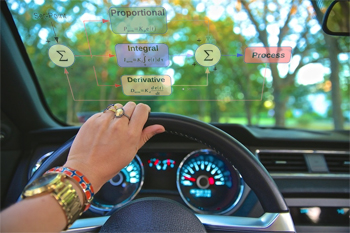

December 15 2022

Many of us in the extrusion industry have heard of PID control loops and some of us know what they do. However, for those who do not and wish to understand what a PID is and how it is used in extrusion applications, this article is for you. This is not meant to be a tutorial on PID tuning but merely to bring about more of a plant-floor understanding of the cause-and-effect PID control loops have on your extrusion operation.
To understand PID control loops we’ll first look at how most of us use PID in our daily lives. PID, or Proportional, Integral and Derivative, are math terms that translate into control actions for industrial machinery. However, we also have PID built into our brains. For example, driving a car, we drive down the highway maintaining a relatively constant speed which we’ve decided is our setpoint. Driving up hills, down hills and around bends we are using integral speed control lightly applying the throttle or break to maintain our desired speed. If the hill gets a bit too steep and light control action isn’t enough we press the throttle more and we speed up the hill. That’s proportional control kicking in. An example of a derivative action could be the traffic light up ahead that just turned red and you need to stop. Your setpoint has changed to zero speed and the brakes are applied allowing you to stop. When the light turns green you are now using a combination of proportional and integral action to decide what the new speed setpoint is and how fast you want to get there. If you decide you want to get to that speed very fast by rapidly accelerating (full proportional output), then you may need to apply some derivative action before you overshoot the speed and potentially get a ticket.
So, what does this mean in an extrusion operation? In extrusion there are two very common control loops for temperature and pressure. Temperature loops are everywhere in extrusion lines and pressure loops are primarily used in the extruder speed/pressure control. Depending on the actions available, for example heat only, heat/cool, cool with air, or cool with water, these will all have different response dynamics that must be controlled. After all, the goal is to set a temperature and have the system maintain that setpoint. The closer the better. It takes a well-tuned PID control loop to do this, especially when there is an external system dynamic to contend with. For example, if a temperature control loop on an extruder barrel is tuned under steady-state conditions, then it will control effectively as long as that condition exists. But as soon as one starts that 300hp motor from a static condition and introduces all that energy in the form of shear heat, the control loop may not have the best PID settings for good control. It’s these types of dynamics that often confuse the best PID tuning loops.
Pressure control in extrusion is a much more dynamic system. The idea here is to maintain a very uniform pressure at the die head in order to control product quality and profile. The more uniform the pressure, the more uniform the product. Generally, the pressure control system involves a melt pump and the suction pressure is controlled by varying the extruder screw speed to maintain a uniform inlet pressure. This can be a very dynamic system and potentially dangerous. Extruder speed must be set-up for narrow control ranges, otherwise the risk of a polymer void in the screw will cause the control to speed the screw up, resulting in an out-of-control process. When the polymer void is filled the resulting pressure spike can blow the burst plugs, in turn potentially damaging the downstream screen changer, melt pump or even worst, the die.
When both temperature and pressure are being monitored and controlled, this becomes a more complex, multi-variate process. For example, changing the extruder speed changes the shear rate, and in turn, shear rate changes the product’s viscosity and temperature, viscosity changes the pressure, pressure changes the screw speed, and screw speed once again restarts the loop of impacting shear rate. Having all these PID loops properly tuned allows the extrusion system to yield the best quality product at an optimal operating cost.
In conclusion, this article is not meant to be a tutorial on PID tuning but merely to bring about more of a plant-floor understanding of the cause-and-effect that PID control loops have on your extrusion operation and even on our own daily lives. Effective PID feedback systems, while sometimes very complex, are essential mechanisms for maintaining productive and safe process environments.
If more clarification is needed or you have any comments about this article please contact Parkinson Technologies.